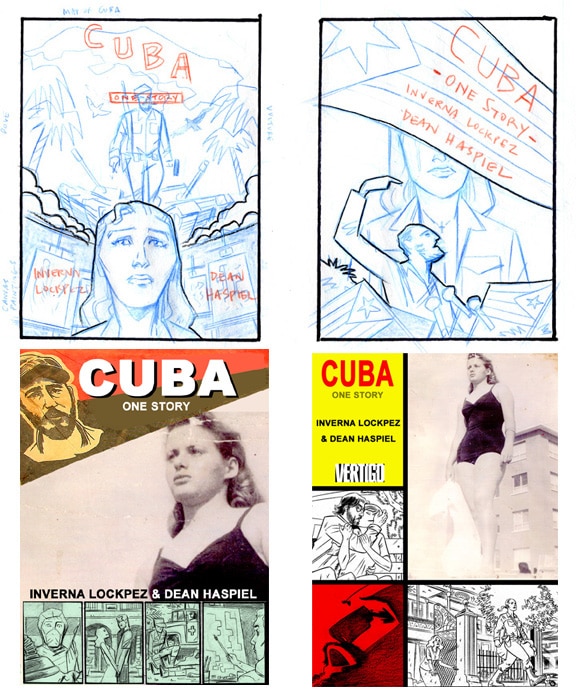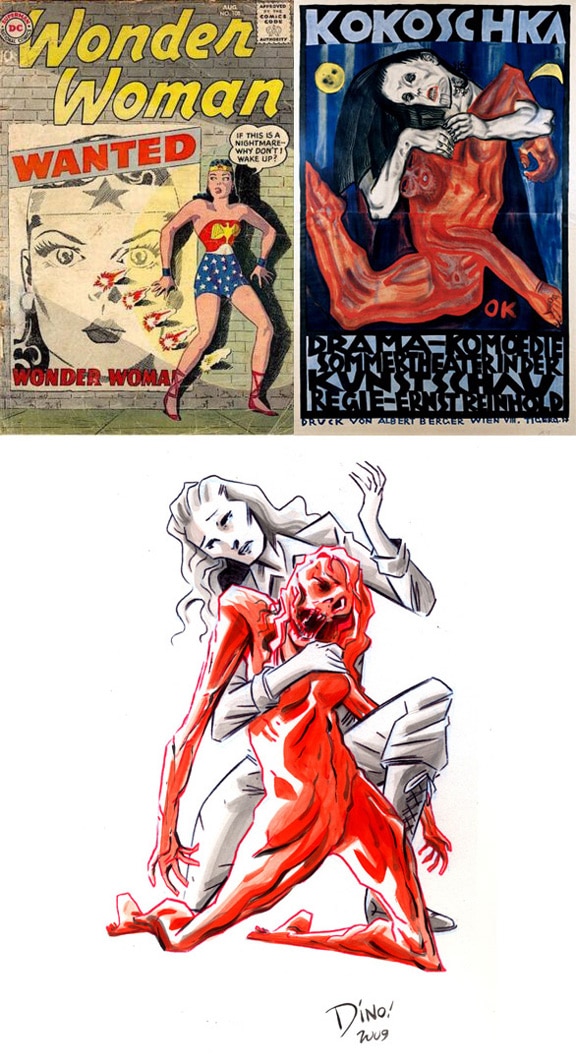We worked very hard on the cover to CUBA: MY REVOLUTION with art director, Louis Prandi, and I came up with a bunch of preliminary concepts, some of which are presented here.
My initial cover designs ranged from presenting the revolution of a country coupled with the revolution of an emerging artist but it felt too linear. I wanted to capture the glamour of Cuban poster art but I’m not a painter and my ink line proved to be too stark. We discussed the qualities of Mondrian, an artist whose abstract work influenced Inverna’s while evoking the page design of a comic book. I created some ideas that would marry the two worlds of fine art and comics while featuring a picture of the author as a young woman in Cuba, one of the only candid photos remaining in Inverna’s archives. Marketing vetoed the clash of reality and fiction, citing conflict, and we dispensed with that portion of the cover. Still, we needed something compelling to compliment the cover narrative.
 Frustrated, I asked Inverna what comics she read as a kid and she mentioned Chic Young’s BLONDIE and William Moulton Marston’s WONDER WOMAN. I looked for comics from her childhood era and discovered classic covers and strips that represented heroines and gods and domestic housewives, including the cover to Wonder Woman #108, illustrated by Ross Andru and Mike Esposito. But I didn’t feel comfortable featuring Inverna’s avatar, Sonya, in that way. I became distraught with the cover process.
Inverna encouraged me to throw caution to the wind to see what would happen. I am a fan of German expressionism and New Objectivity. One of my favorite painters is Max Beckmann, and I studied the way he paints people like they were anthropomorphized bruises. My girlfriend, Jen Ferguson, is a fine arts painter and she recommended I look at Austrian artist, Oskar Kokoschka, for which I discovered some chilling portraits of human conflict and pain. I wanted to present Sonya at odds with her own ideologies and what emerged was something horrific, not unlike an angel freeing her tortured soul. All parties involved were struck by the image but agreed that the general public would mistaken our graphic novel for a zombie apocalypse nightmare.
Frustrated, I asked Inverna what comics she read as a kid and she mentioned Chic Young’s BLONDIE and William Moulton Marston’s WONDER WOMAN. I looked for comics from her childhood era and discovered classic covers and strips that represented heroines and gods and domestic housewives, including the cover to Wonder Woman #108, illustrated by Ross Andru and Mike Esposito. But I didn’t feel comfortable featuring Inverna’s avatar, Sonya, in that way. I became distraught with the cover process.
Inverna encouraged me to throw caution to the wind to see what would happen. I am a fan of German expressionism and New Objectivity. One of my favorite painters is Max Beckmann, and I studied the way he paints people like they were anthropomorphized bruises. My girlfriend, Jen Ferguson, is a fine arts painter and she recommended I look at Austrian artist, Oskar Kokoschka, for which I discovered some chilling portraits of human conflict and pain. I wanted to present Sonya at odds with her own ideologies and what emerged was something horrific, not unlike an angel freeing her tortured soul. All parties involved were struck by the image but agreed that the general public would mistaken our graphic novel for a zombie apocalypse nightmare.
 Finally, we settled on marrying an artifact from Castro’s Cuban revolution —the original flag of the 26 July Movement, reworked as the title -- with the classic comic book trope of multiple images. We staged it within the frame of fine art minimalism while highlighting a painted portrait of the protagonist. I think it was on the twentieth attempt at doing a watercolor painting of Sonya that I got it right.
Finally, we settled on marrying an artifact from Castro’s Cuban revolution —the original flag of the 26 July Movement, reworked as the title -- with the classic comic book trope of multiple images. We staged it within the frame of fine art minimalism while highlighting a painted portrait of the protagonist. I think it was on the twentieth attempt at doing a watercolor painting of Sonya that I got it right.


Editorial
CUBA: MY REVOLUTION COVER PROCESS by Dean Haspiel
BY: DCE Editorial
Wednesday, September 15th, 2010



















